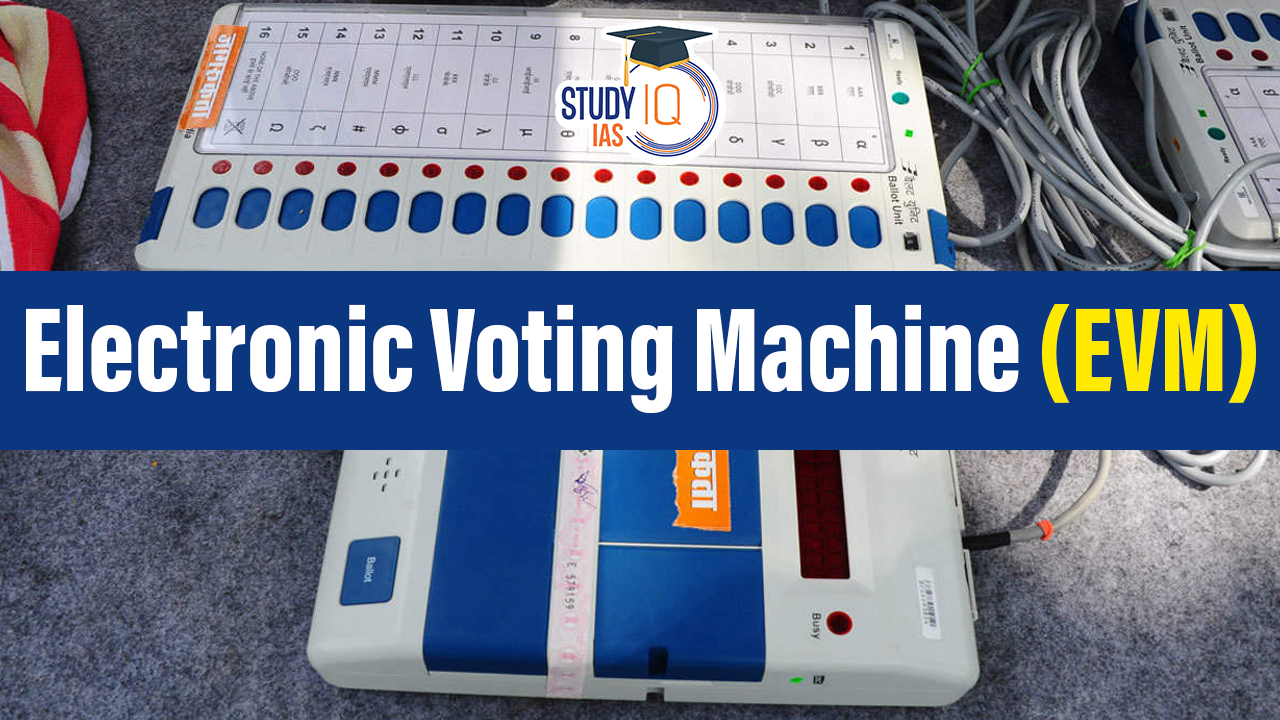Table of Contents
Electronic Voting Machines (EVMs) and Voter Verifiable Paper Audit Trail (VVPAT) have revolutionized the electoral process in India, offering efficiency, accuracy, and transparency. Since their introduction, they have been pivotal in ensuring the integrity of elections and enhancing the democratic process. This article deal with the evolution, functionality, benefits, concerns, and the significant role played by EVMs and VVPAT in Indian elections.
What is an Electronic Voting Machines (EVM)?
An Electronic Voting Machine (EVM) is a device used in elections to record votes electronically. Comprising a Control Unit and Balloting Unit, it streamlines the voting process by allowing voters to select candidates with the press of a button. EVMs ensure the secrecy and accuracy of votes and have become integral to electoral processes worldwide for their efficiency and reliability in recording and tallying votes.
Facts About Electronic Voting Machines (EVMs)
| Aspect | Information |
| Introduction | EVMs were first introduced in the Paravur Assembly Constituency of Kerala, India in 1982. |
| Components | EVMs consist of two main components: the Control Unit and the Balloting Unit. |
| Usage | Since 1998, the Election Commission of India has increasingly used EVMs instead of ballot boxes. |
| Full Adoption | In 2004, the Election Commission of India decided to use only EVMs for Lok Sabha elections. |
| Development | Devised and designed by the Technical Experts Committee (TEC) of the Election Commission in collaboration with Bharat Electronics Ltd and Electronic Corporation of India Ltd. |
| Functionality | The Control Unit remains with the polling officer, while the Balloting Unit is in the voting booth. |
| Voting Process | Voters press a button on the Balloting Unit against their chosen candidate’s name and symbol. |
| Maximum Votes | An EVM can record a maximum of 2,000 votes. |
| Power Source | EVMs do not require electricity and run on an ordinary battery. |
| Chip Technology | EVMs use a one-time programmable/masked chip, enhancing security. |
| Standalone System | EVMs are standalone machines and do not use an operating system. |
| Benefits |
|
| Concerns |
|
| VVPAT | Voter Verifiable Paper Audit Trail (VVPAT) was introduced in 2013. |
| Supreme Court Ruling | The Supreme Court emphasized the necessity of implementing VVPAT in elections conducted through EVMs. |
We’re now on WhatsApp. Click to Join
Evolution of Electronic Voting Machines (EVMs)
The journey of EVMs in India began in 1982 when they were first used in the Paravur Assembly Constituency of Kerala. Over the years, the Election Commission of India (ECI) gradually transitioned from traditional ballot boxes to EVMs, with their usage expanding to state elections, by-elections, and ultimately, the historic decision in 2004 to use only EVMs for Lok Sabha elections. Designed by the Technical Experts Committee in collaboration with public sector undertakings, EVMs consist of a Control Unit and a Balloting Unit connected by a cable, ensuring ease of use and reliability.
Key Features of Electronic Voting Machines (EVMs)
- Power Source: EVMs do not require electricity during the voting process and run on an ordinary battery.
- Chip Technology: EVMs use a one-time programmable/masked chip, ensuring the security and integrity of the voting process.
- Standalone System: EVMs are standalone machines and do not use an operating system, minimizing the risk of external manipulation.
- Voter Verifiable Paper Audit Trail (VVPAT): In some systems, EVMs are equipped with VVPAT, which prints a paper slip containing the details of the vote cast by the voter. This allows for manual verification of the electronic vote count.
How Do Electronic Voting Machines Work?
Electronic Voting Machines (EVMs) are designed to simplify and streamline the voting process while ensuring accuracy, transparency, and security. Here’s how they work:
- Initialization: Before the start of voting, the EVM is initialized by the polling officer to ensure it is ready to accept votes.
- Voting Process:
- Voters enter the polling booth and are provided with a ballot paper containing the names and symbols of the candidates.
- Inside the booth, voters press the button on the Balloting Unit corresponding to their chosen candidate.
- Each time a button is pressed, the EVM records the vote electronically.
- Recording Votes:
- The EVM records the votes electronically, typically capable of storing up to 2,000 votes.
- It ensures the secrecy and anonymity of the vote, as the voter’s choice is not visible to anyone else.
- End of Voting:
- Once the voting period ends, the EVM is sealed to prevent tampering or manipulation of the recorded votes.
- Counting of Votes:
- After the voting process is complete, the sealed EVMs are taken to designated counting centers.
- The votes recorded electronically are tabulated electronically, leading to the declaration of election results.
Can Electronic Voting Machines Be Manipulated?
- An expert committee report commissioned by the Election Commission of India (ECI) concluded that tampering with Electronic Voting Machines (EVMs) is highly unlikely.
- Manipulation of EVMs is deemed improbable due to the absence of a networking component, making remote tampering impossible.
- Physical access is required for tampering, but the elaborate sealing process conducted by the ECI prevents unauthorized access.
- Voter-Verifiable Paper Audit Trail (VVPAT) allows cross-verification of vote counts, enhancing transparency and accountability.
- ECI’s policy of selecting booths for VVPAT verification ensures thorough scrutiny of EVMs, with a minimal likelihood of defective machines.
- Randomized distribution of EVMs across constituencies and the compatibility requirement between the Balloting Unit (BU) and Control Unit (CU) further deter tampering.
- Authors assert that with these safeguards in place, it’s highly unlikely that EVMs have been or can be tampered with.


 International Days List of 2025, Importa...
International Days List of 2025, Importa...
 Major Dhyan Chand Khel Ratna Award Winne...
Major Dhyan Chand Khel Ratna Award Winne...
 Mahavir Jayanti 2025: Date, History, Sig...
Mahavir Jayanti 2025: Date, History, Sig...





















